|

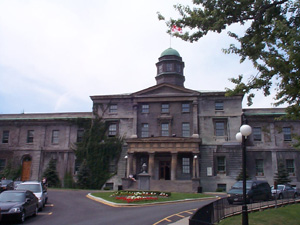 Two
hundred years ago, McGill was the name of a successful Montreal merchant
with a vision. Today, it's a name that sparks recognition around the
world and opens doors for graduates like no other Canadian university.
Great thinkers have passed through the gates of McGill and its students
have a reputation for being bright, ambitious and likely to succeed.
It's an exciting place to study, with a rich history and a wealth of
diversity. The downtown campus is nestled at the foot of Mount Royal
Park, facing the commercial district in the heart of the city. The campus
consists of 70 buildings, both heritage and modern, that span 32 hectares
(80 acres) of prime real estate. Two
hundred years ago, McGill was the name of a successful Montreal merchant
with a vision. Today, it's a name that sparks recognition around the
world and opens doors for graduates like no other Canadian university.
Great thinkers have passed through the gates of McGill and its students
have a reputation for being bright, ambitious and likely to succeed.
It's an exciting place to study, with a rich history and a wealth of
diversity. The downtown campus is nestled at the foot of Mount Royal
Park, facing the commercial district in the heart of the city. The campus
consists of 70 buildings, both heritage and modern, that span 32 hectares
(80 acres) of prime real estate.
(excerpted from the
McGill Website)
It's certainly true
that McGill has a good reputation as a school. McGill stands out as
one of the largest unbroken pieces of property in the downtown area.
The age and complexity of the place drew UEM like a siren's call. Our
first explorations were tentative. Basements, public areas, a few rooftops,
but with time, our confidence grew, and we were soon spelunking the
depths of the steam tunnels and utility rooms as if we'd explored there
our whole lives.
These expeditions
uncovered the somewhat disparate system of steam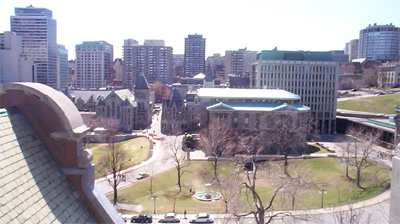 tunnels, a multitude of machine and utility rooms, and a whole bunch
of rooftops offering us beautiful views of the campus and Montreal's
downtown core.
tunnels, a multitude of machine and utility rooms, and a whole bunch
of rooftops offering us beautiful views of the campus and Montreal's
downtown core.
Additionally, we
were lucky enough to get into the McTavish reservoir and the steam tunnels
connected to it, and while we were downtown, a few buildings we might
not otherwise have been too. We spent literally months exploring as
much of the campus as we could, and we didn't even see everything. Much
awaits the explorer who follows in our footsteps and takes in a few
of McGill nooks and crannies.
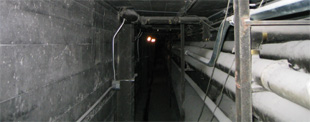 Our
favourite part of McGill was probably the underground. Steam tunnels
(some barely human-passable) link up most of the buildings on campus,
carrying steam, electricity, fiber optic cables, and water. Doubtless
other materials, of which we are unaware, flow through the pipes too.
There's also a few utility rooms and interesting (otherwise inaccessible)
basements connected to the steam tunnel system. Our
favourite part of McGill was probably the underground. Steam tunnels
(some barely human-passable) link up most of the buildings on campus,
carrying steam, electricity, fiber optic cables, and water. Doubtless
other materials, of which we are unaware, flow through the pipes too.
There's also a few utility rooms and interesting (otherwise inaccessible)
basements connected to the steam tunnel system.
A few things
to watch out for while you're exploring McGill
(or looking through our galleries):
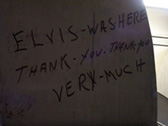 |
Elvis Grafitti
The
King of Rock'n'Roll seems to have explored almost as much of the
McGill campus as we did. You can find his tags, and his thanks,
all over the forbidden areas of McGill.
|
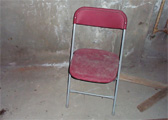 |
Lonesome
Chairs
Almost
every building we visited on the McGill campus had chairs in improbable
places. Too filthy and out of the way to sit on, we can't help
but think that the chairs are up to something.
|
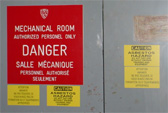 |
Scary Warning
Signs
Radiation,
Biohazards, High Pressure Steam, Asbestos, Mechanical rooms with
high speed equipment... there are a thousand ways to die at McGill...
better bring your protective equipment!
|
In conclusion, McGill
is one massive, complicated, rewarding place to explore. We hope you
enjoy our report on the subject as much as we enjoyed compiling it.
|

 Two
hundred years ago, McGill was the name of a successful Montreal merchant
with a vision. Today, it's a name that sparks recognition around the
world and opens doors for graduates like no other Canadian university.
Great thinkers have passed through the gates of McGill and its students
have a reputation for being bright, ambitious and likely to succeed.
It's an exciting place to study, with a rich history and a wealth of
diversity. The downtown campus is nestled at the foot of Mount Royal
Park, facing the commercial district in the heart of the city. The campus
consists of 70 buildings, both heritage and modern, that span 32 hectares
(80 acres) of prime real estate.
Two
hundred years ago, McGill was the name of a successful Montreal merchant
with a vision. Today, it's a name that sparks recognition around the
world and opens doors for graduates like no other Canadian university.
Great thinkers have passed through the gates of McGill and its students
have a reputation for being bright, ambitious and likely to succeed.
It's an exciting place to study, with a rich history and a wealth of
diversity. The downtown campus is nestled at the foot of Mount Royal
Park, facing the commercial district in the heart of the city. The campus
consists of 70 buildings, both heritage and modern, that span 32 hectares
(80 acres) of prime real estate.  Our
favourite part of McGill was probably the underground. Steam tunnels
(some barely human-passable) link up most of the buildings on campus,
carrying steam, electricity, fiber optic cables, and water. Doubtless
other materials, of which we are unaware, flow through the pipes too.
There's also a few utility rooms and interesting (otherwise inaccessible)
basements connected to the steam tunnel system.
Our
favourite part of McGill was probably the underground. Steam tunnels
(some barely human-passable) link up most of the buildings on campus,
carrying steam, electricity, fiber optic cables, and water. Doubtless
other materials, of which we are unaware, flow through the pipes too.
There's also a few utility rooms and interesting (otherwise inaccessible)
basements connected to the steam tunnel system. 